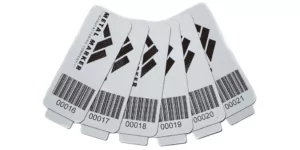Barcode verification is the process of grading the quality of various barcode symbols using a specialized scanning device.
The scanners used for verification range in price and features depending on how complicated the barcodes are and how many will need to be scanned. There are smaller USB enabled scanners for quick desktop use, or full-size scanners that can be incorporated into a production line.
As a barcode is scanned, the device shoots light at the code, which reflects back providing a full image. The scanner combines this data with computer software to fully analyze for imperfections. Not only does the device check the symbol image for quality, but also ensures the data is not jumbled either.
The software compares the scanned image to a standardized version, and assigns it a letter grade (A-F). C grades and above are considered passing and will work 100% of the time.
The symbol is initially checked with a pass/fail metric to determine if it is scannable. If it passes it receives a more detailed inspection for grading purposes.
There are several parameters which the code is graded on. The parameter with the lowest score sets the overall grade for the image. For example, if the symbol contrast receives a B, but the modulation a D, the entire code will still be scored at a D.
This letter grading and the parameters used was established by the ANSI. These are also included in ISO standards for barcoding.
Grading Criteria
Some of the specific grading parameters outlined in the ISO 15416 (1D) and 15415 guidelines (2D) include:
- Symbol Contrast
- Axial Non-uniformity
- Grid Non-uniformity
- Minimum Reflectance
- Edge Contrast
- Local contrast
- Modulation
- Defects
Faded areas, backgrounds which are too dark, and other structure issues can all lead to the barcode failing to pass.
While verification machines are highly accurate, they do need to be calibrated correctly for the best results. Environmental factors such as lighting can interfere with the results. In addition, the machines must be recalibrated periodically to ensure it is up-to-date on the latest standards.
Why Verify?
Quality control
Maintaining a high standard of quality is key for organizations in every industry. This holds true with the usage of barcodes as well. Barcodes are a tool which allows data to be logged in an instant, seamless process. If there are quality issues, this can lead to a myriad of issues in both internal processes and throughout the supply chain.
Faulty symbols can bring operations to a stand-still. Codes which provide the wrong information can create major miscommunications and costly errors. Simply put: bad data is worse than no data.
Contract and Industry Compliance
One of the main reasons why barcode producers choose to implement barcode grading systems is to meet specific industry guidelines and regulations.
Various governing bodies have their own set specifications for barcodes. This changes by industry as well. The Food and Drug Administration (FDA), Department of Defense (DOD), and Environmental Protection Agency (EPA) all have symbol standards which their suppliers must conform with. This goes for labels, tags, and even direct marking of codes on machines and equipment.

For example, the Department of Defense utilizes a unique identification tagging system called UID. These UID tags must incorporate barcodes (often using data matrix style 2D symbols). This entire process is outlined in their MIL-STD-130 guidelines. Organizations serving this industry must make sure their barcodes are compliant with all of these standards.
The only real way to ensure symbols meet the specifications and requirements is through the verification process.
Common Applications for Barcodes
- Asset Tracking
- Inventory Management
- UID (IUID) Tracking
- Product Tracking/Pricing (UPC Codes)
Customer Satisfaction
Another key aspect for manufacturers is customer satisfaction. This goes for everything from manufacturing metal barcode tags to packaging manufacturers with UPC codes. If the codes that the customer receives does not scan, they will not be happy.
This doesn’t mean just consumer products. If you provide an industrial solution with a barcode that doesn’t scan, the entire supply chain will be unhappy with your service.
Codes need to scan correctly on the first attempt. If your customer has to spend several minutes trying to get your codes to scan, they will look for a better alternative. This can translate all the way down the supply chain.
Wrap-Up
Barcode grading is an important process for manufacturers which produce barcoded items. Improper barcodes have the ability to cause issues in the supply chain, and will be linked back to the barcode producer.
In addition, the capability to meet certain specifications and standards will help ensure the organization can tackle the needs of a wide ranging customer base.